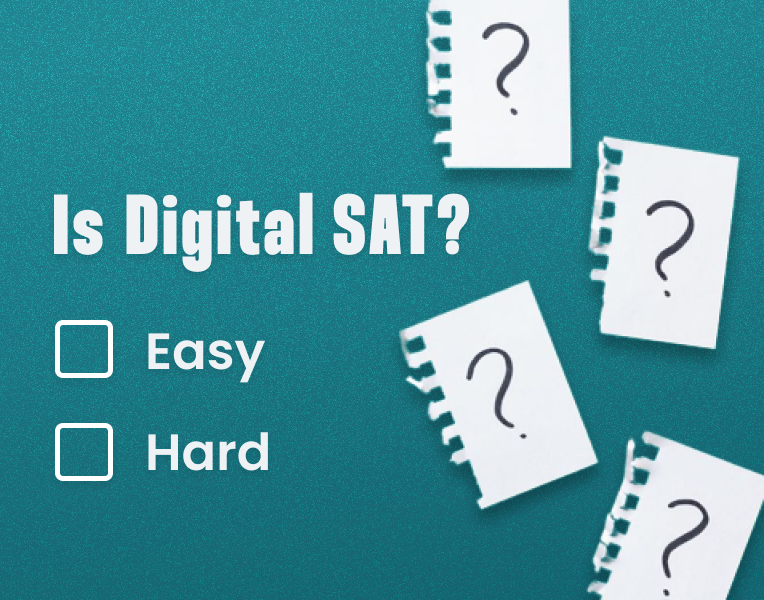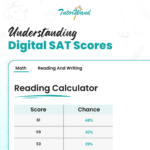The SAT is undergoing a major change starting in 2024. The College Board will be transitioning the SAT from a paper and pencil test to a digital, computer-based exam. This shift to a digital SAT has sparked a lot of questions from students about how the new test format will compare in difficulty to the current SAT.
In particular, many students want to know: is the digital SAT easier or harder than the SAT?
This complete guide analyzes all the key differences between the paper and digital SAT to help you understand how the two test formats compare. We’ll look at:
- Why the SAT is going digital
- Main changes to the digital SAT
- Is the digital SAT easier or harder? An in-depth difficulty comparison
- How to prepare effectively for the new digital exam
Why Is the SAT Going Digital?
First, let’s look at why the College Board decided to create a digital version of the SAT in the first place.
There are a few key reasons driving the switch to the digital SAT:
- Increased accessibility – A digital SAT can be taken anywhere there is internet access, making it more accessible for students globally. This flexibility became especially important during COVID-19 when in-person testing was limited.
- Shorter exam length – The digital SAT is shorter than the paper version, with only 2 hours and 14 minutes of testing time rather than 3 hours (or 3 hours and 50 minutes with the Essay section).
- Faster score delivery – Digital scores can be provided to students in days rather than weeks.
Now let’s analyze the key format changes and how they may impact the test’s difficulty.
Main Changes to the Digital SAT Format
The digital SAT introduces some major structural changes compared to the paper-based test. Here are the 5 main updates to be aware of:
1. Digital Interface
The most obvious change is that students will take the digital SAT on a laptop or tablet, rather than with an old-fashioned pencil and paper test booklet.
All questions will be displayed on screen and students will enter responses using a keyboard, mouse, and basic word processing tools.
2. Shorter Length
As mentioned above, the digital SAT is around 1 hour shorter than the current SAT. Here is a breakdown of the new test length:
- Reading: 32 minutes x 2 modules = 64 minutes
- Writing and Language: 32 minutes x 2 modules = 64 minutes
- Math: 35 minutes x 2 modules = 70 minutes
Total testing time = 134 minutes (just over 2 hours) compared to 170 minutes for the paper SAT.
3. SAT Sections Renamed as Modules
The traditional Reading, Writing, and Math sections are now called “modules” on the digital SAT.
Each section is divided into 2 modules that students take back-to-back. There is a short break in between the Reading/Writing and Math sections.
4. Question Format Changes
Along with the shift to a digital interface, question formats are being updated to take advantage of the new technology. For instance:
- Reading – Passages are shorter and there is 1 question per passage rather than a longer passage with multiple questions.
- Writing – Questions will be more focused on assessing writing skills rather than obscure grammar rules.
- Math – There will be an on-screen calculator available to students for the entire Math section. The calculator currently offered is a basic 4-function calculator.
- Multi-Select Format – Some questions will use a multi-select format where students select multiple answers from a list.
5. Adaptive Testing
A major update to the digital SAT is the introduction of adaptive testing. This means the test difficulty adapts based on a student’s performance.
On both the Reading/Writing and Math sections, the 2nd module will adjust to be more difficult or easier for each student based on how they performed on the 1st module.
This helps provide a more precise score by giving harder or easier questions tailored to each test taker’s ability level.
Is the Digital SAT Easier or Harder Overall?
Now that we’ve looked at the key changes to the digital SAT format, let’s analyze how these updates may impact the test’s difficulty compared to the paper version.
Here are the main factors that suggest the digital SAT may be slightly easier for students:
- Shorter length – The big reduction in test length means students have less content to get through and more time per question. This could help reduce fatigue.
- Digital tools – The on-screen calculator and basic word processor tools like copy/paste may be helpful for catching careless errors.
- Multi-select questions – Having multiple correct answers to choose from could make it easier to identify the right responses.
- No penalty for wrong answers – On paper SATs, students lose 1⁄4 point for incorrect answers. On the digital test there is no penalty.
- Adaptive testing – Students who struggle on easier questions will be routed to easier 2nd modules, boosting their score potential.
However, there are also some updates that may make the digital test more challenging:
- New question types – Unfamiliar formats like multi-select could trip students up if they haven’t practiced them.
- Digital interface – Test takers who aren’t used to reading lengthy content on screens may find the digital test harder.
- Technical issues – Computer problems during the real test could derail students’ focus and hurt performance.
- Adaptive testing – Students who excel on harder 1st modules will be routed to very advanced 2nd modules, increasing the level of difficulty.
Overall, the consensus among testing experts is that the digital SAT will be slightly easier than the paper test for most students. But this edge is modest. Strong preparation strategies will still be critical for success on test day.
How to Prepare Effectively for the Digital SAT
To maximize your potential on the new digital SAT, your preparation approach should include:
Take Digital SAT Practice Tests
The best way to prep is with the Digital SAT Practice Tests in the same digital format you’ll see on test day.
Taking full practice tests is key to get comfortable with the digital interface and adaptive testing. Review your scores to identify weaker areas to improve.
And if you are struggling to find the right Digital SAT Practice Tests? Look no further than Tutorwand revolutionary Digital SAT practice platform. Designed by experts to optimize test prep,
Tutorwand offers an adaptive testing engine that mimics the real Digital SAT exam. With Tutorwand, students can take full-length practice tests and topic-focused quizzes to master critical skills.
Its AI-powered scoring provides personalized feedback so you can zero in on weaknesses. Take advantage of Tutorwand arsenal of prep resources, from thousands of practice questions to detailed video explanations. Gear up for test day success with Tutorwand – the ultimate SAT prep game-changer.
Be sure to explore the many other resources on SAT prep available through Tutorwand, like our blog on Digital SAT tips and tricks.
The Digital SAT Offers New Possibilities
The shift to the digital SAT opens up new possibilities to showcase your skills in an updated format. With strong preparation for the new test dynamics, students can feel confident tackling the exam digitally in 2024 and beyond.
Focus your study efforts on the core academic skills assessed by the SAT, while also familiarizing yourself with the digital experience. With the right balance of content review and format practice, you’ll be primed for success on test day!



